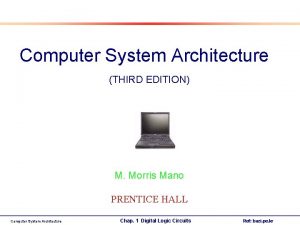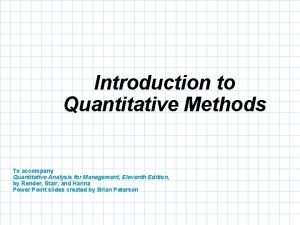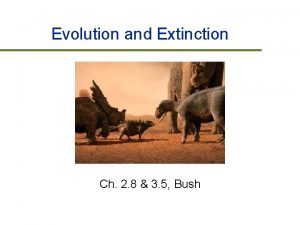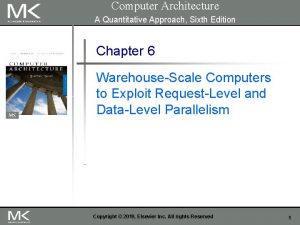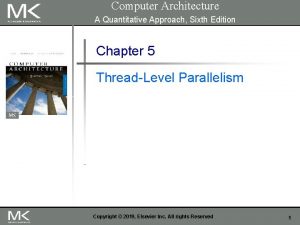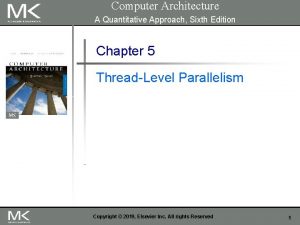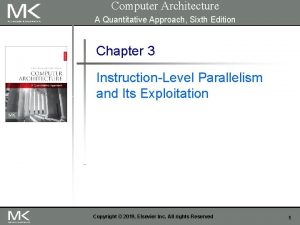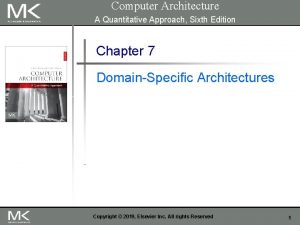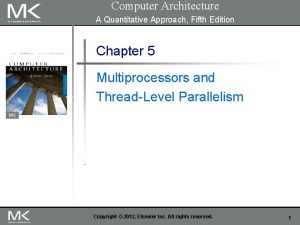Computer Architecture A Quantitative Approach Sixth Edition Chapter
































- Slides: 32

Computer Architecture A Quantitative Approach, Sixth Edition Chapter 6 Warehouse-Scale Computers to Exploit Request-Level and Data-Level Parallelism Copyright © 2019, Elsevier Inc. All rights Reserved 1

Introduction n Warehouse-scale computer (WSC) n Provides Internet services n n Differences with HPC “clusters”: n n n Search, social networking, online maps, video sharing, online shopping, email, cloud computing, etc. Clusters have higher performance processors and network Clusters emphasize thread-level parallelism, WSCs emphasize request-level parallelism Differences with datacenters: n n Datacenters consolidate different machines and software into one location Datacenters emphasize virtual machines and hardware heterogeneity in order to serve varied customers Copyright © 2019, Elsevier Inc. All rights Reserved 2

n Important design factors for WSC: n Cost-performance n n n Small savings add up Energy efficiency n n Introduction Affects power distribution and cooling Work per joule Dependability via redundancy Network I/O Interactive and batch processing workloads Copyright © 2019, Elsevier Inc. All rights Reserved 3

Figure 6. 1 List of outages and anomalies with the approximate frequencies of occurrences in the first year of a new cluster of 2400 servers. We label what Google calls a cluster an array; see Figure 6. 5. Based on Barroso, L. A. , 2010. Warehouse Scale Computing [keynote address]. In: Proceedings of ACM SIGMOD, June 8– 10, 2010, Indianapolis, IN. 4

n Ample computational parallelism is not important n n Can afford to build customized systems since WSC require volume purchase Location counts n n Power consumption is a primary, not secondary, constraint when designing system Scale and its opportunities and problems n n Most jobs are totally independent “Request-level parallelism” Operational costs count n n Introduction Real estate, power cost; Internet, end-user, and workforce availability Computing efficiently at low utilization Scale and the opportunities/problems associated with scale n n Unique challenges: custom hardware, failures Unique opportunities: bulk discounts Copyright © 2019, Elsevier Inc. All rights Reserved 5

n Location of WSC n n Proximity to Internet backbones, electricity cost, property tax rates, low risk from earthquakes, floods, and hurricanes Power distribution Copyright © 2019, Elsevier Inc. All rights Reserved Efficiency and Cost of WSC 6

n Batch processing framework: Map. Reduce n Map: applies a programmer-supplied function to each logical input record n n n Runs on thousands of computers Provides new set of key-value pairs as intermediate values Reduce: collapses values using another programmersupplied function Copyright © 2019, Elsevier Inc. All rights Reserved Programming Models and Workloads for WSCs Prgrm’g Models and Workloads 7

n Example: n map (String key, String value): n n n // key: document name // value: document contents for each word w in value n n Emit. Intermediate(w, ” 1”); // Produce list of all words reduce (String key, Iterator values): n n // key: a word // value: a list of counts int result = 0; for each v in values: n n Programming Models and Workloads for WSCs Prgrm’g Models and Workloads result += Parse. Int(v); // get integer from key-value pair Emit(As. String(result)); Copyright © 2019, Elsevier Inc. All rights Reserved 8

n Availability: n n Use replicas of data across different servers Use relaxed consistency: n n n No need for all replicas to always agree File systems: GFS and Colossus Databases: Dynamo and Big. Table Copyright © 2019, Elsevier Inc. All rights Reserved Programming Models and Workloads for WSCs Prgrm’g Models and Workloads 9

n Map. Reduce runtime environment schedules map and reduce task to WSC nodes n n Workload demands often vary considerably Scheduler assigns tasks based on completion of prior tasks Tail latency/execution time variability: single slow task can hold up large Map. Reduce job Runtime libraries replicate tasks near end of job Copyright © 2019, Elsevier Inc. All rights Reserved Programming Models and Workloads for WSCs Prgrm’g Models and Workloads 10

Copyright © 2019, Elsevier Inc. All rights Reserved Programming Models and Workloads for WSCs Prgrm’g Models and Workloads 11

n n n WSC often use a hierarchy of networks for interconnection Each 19” rack holds 48 1 U servers connected to a rack switch Rack switches are uplinked to switch higher in hierarchy n Computer Ar 4 chitecture of WSC Computer Architecture of WSC Uplink has 6 -24 X times lower bandwidth. Goal is to maximize locality of communication relative to the rack Copyright © 2019, Elsevier Inc. All rights Reserved 12

n Storage options: n n Use disks inside the servers, or Network attached storage through Infiniband WSCs generally rely on local disks Google File System (GFS) uses local disks and maintains at least three replicas Copyright © 2019, Elsevier Inc. All rights Reserved Computer Ar 4 chitecture of WSC Storage 13

n Switch that connects an array of racks n n n Array switch should have 10 X the bisection bandwidth of rack switch Cost of n-port switch grows as n 2 Often utilize content addressible memory chips and FPGAs Copyright © 2019, Elsevier Inc. All rights Reserved Computer Ar 4 chitecture of WSC Array Switch 14

n Computer Ar 4 chitecture of WSC Memory Hierarchy Servers can access DRAM and disks on other servers using a NUMA-style interface Copyright © 2019, Elsevier Inc. All rights Reserved 15

Figure 6. 6 Latency, bandwidth, and capacity of the memory hierarchy of a WSC (Barroso et al. , 2013). Figure 6. 7 plots this same information. 16

Copyright © 2019, Elsevier Inc. All rights Reserved Computer Ar 4 chitecture of WSC Memory Hierarchy 17

Figure 6. 7 Graph of latency, bandwidth, and capacity of the memory hierarchy of a WSC for data in Figure 6. 6 (Barroso et al. , 2013). The meaningful things are: - The behavior of each line separately. Comparing the relative changes among the lines. 18

Copyright © 2019, Elsevier Inc. All rights Reserved Computer Ar 4 chitecture of WSC Memory Hierarchy 19

Figure 6. 8 A Layer 3 network used to link arrays together and to the Internet (Greenberg et al. , 2009). A load balancer monitors how busy a set of servers is and directs traffic to the less loaded ones to try to keep the servers approximately equally utilized. Another option is to use a separate border router to connect the Internet to the data center Layer 3 switches. As we will see in Section 6. 6, many modern WSCs have abandoned the conventional layered networking stack of traditional switches. 20

n Cooling n n Air conditioning used to cool server room 64 F – 71 F n n Keep temperature higher (closer to 71 F) Cooling towers can also be used n Minimum temperature is “wet bulb temperature” Copyright © 2019, Elsevier Inc. All rights Reserved Physcical Infrastrcuture and Costs of WSC Infrastructure and Costs of WSC 21

Figure 6. 9 Mechanical design for cooling systems. CWS stands for circulating water system. From Hamilton, J. , 2010. Cloud computing economies of scale. In: Paper Presented at the AWS Workshop on Genomics and Cloud Computing, June 8, 2010, Seattle, WA. http: //mvdirona. com/jrh/Talks. And. Papers/James. Hamilton_Genomics. Cloud 20100608. pdf. 22

n Cooling system also uses water (evaporation and spills) n n Power cost breakdown: n n n E. g. 70, 000 to 200, 000 gallons per day for an 8 MW facility Chillers: 30 -50% of the power used by the IT equipment Air conditioning: 10 -20% of the IT power, mostly due to fans How many servers can a WSC support? n Each server: n n n Physcical Infrastrcuture and Costs of WSC Infrastructure and Costs of WSC “Nameplate power rating” gives maximum power consumption To get actual, measure power under actual workloads Oversubscribe cumulative server power by 40%, but monitor power closely Copyright © 2019, Elsevier Inc. All rights Reserved 23

n Determining the maximum server capacity n n Nameplate power rating: maximum power that a server can draw Better approach: measure under various workloads Oversubscribe by 40% Typical power usage by component: n n n n Processors: 42% DRAM: 12% Disks: 14% Networking: 5% Cooling: 15% Power overhead: 8% Miscellaneous: 4% Copyright © 2019, Elsevier Inc. All rights Reserved Physcical Infrastrcuture and Costs of WSC Infrastructure and Costs of WSC 24

n Power Utilization Effectiveness (PEU) n n n = Total facility power / IT equipment power Median PUE on 2006 study was 1. 69 Performance n n n Latency is important metric because it is seen by users Bing study: users will use search less as response time increases Service Level Objectives (SLOs)/Service Level Agreements (SLAs) n Physcical Infrastrcuture and Costs of WSC Measuring Efficiency of a WSC E. g. 99% of requests be below 100 ms Copyright © 2019, Elsevier Inc. All rights Reserved 25

Copyright © 2019, Elsevier Inc. All rights Reserved Physcical Infrastrcuture and Costs of WSC Measuring Efficiency of a WSC 26

Figure 6. 12 Negative impact of delays at the Bing search server on user behavior (Schurman and Brutlag, 2009). 27

n Capital expenditures (CAPEX) n n n Cost to build a WSC $9 to 13/watt Operational expenditures (OPEX) n Cost to operate a WSC Copyright © 2019, Elsevier Inc. All rights Reserved Physcical Infrastrcuture and Costs of WSC Cost of a WSC 28

n Amazon Web Services n n n Virtual Machines: Linux/Xen Low cost Open source software Initially no guarantee of service No contract Copyright © 2019, Elsevier Inc. All rights Reserved Cloud Computing 29

n Cloud Computing Growth Copyright © 2019, Elsevier Inc. All rights Reserved Cloud Computing 30

Fallcies and Pitfalls Fallacy: Cloud computing providers are losing money n AWS has a margin of 25%, Amazon retail 3% Pitfall: Focusing on average performance instead of 99 th percentile performance. Even getting bad performance infrequently is enough to drive cloud customer to a competitor Pitfall: Using too wimpy a processor when trying to improve WSC cost-performance Pitfall: Inconsistent Measure of PUE (Power Utilization Effectiveness) by different companies Fallacy: Capital costs of the WSC facility are higher than for the servers that it houses Copyright © 2019, Elsevier Inc. All rights Reserved 31

Fallcies and Pitfalls Fallacies and Pitfalls Pitfall: Trying to save power with inactive low power modes versus active low power modes Fallacy: Given improvements in DRAM dependability and the fault tolerance of WSC systems software, there is no need to spend extra for ECC (error correcting code) memory in a WSC Pitfall: Coping effectively with microsecond (e. g. Flash and 100 Gb. E) delays as opposed to nansecond or millisecond delays (namely: all delays are important) Fallacy: Turning off hardware during periods of low activity improves the cost-performance of a WSC Copyright © 2019, Elsevier Inc. All rights Reserved 32
 Computer architecture a quantitative approach sixth edition
Computer architecture a quantitative approach sixth edition Computer architecture a quantitative approach sixth edition
Computer architecture a quantitative approach sixth edition Computer architecture a quantitative approach sixth edition
Computer architecture a quantitative approach sixth edition Computer architecture 5th edition
Computer architecture 5th edition Computer architecture a quantitative approach
Computer architecture a quantitative approach Computer architecture a quantitative approach
Computer architecture a quantitative approach Peter piper tongue twister
Peter piper tongue twister The sixth sick sheik's sixth sheep's sick lyrics
The sixth sick sheik's sixth sheep's sick lyrics Biochemistry sixth edition
Biochemistry sixth edition Automotive technology sixth edition
Automotive technology sixth edition Automotive technology sixth edition
Automotive technology sixth edition Citation sample pdf
Citation sample pdf Precalculus sixth edition
Precalculus sixth edition Rational people think at the margin
Rational people think at the margin Digital design and computer architecture: arm edition
Digital design and computer architecture: arm edition Morris mano computer system architecture
Morris mano computer system architecture Computer organization and architecture 10th edition
Computer organization and architecture 10th edition Computer architecture arm edition
Computer architecture arm edition Digital design and computer architecture: arm edition
Digital design and computer architecture: arm edition 3 bus architecture
3 bus architecture Difference between organization and architecture
Difference between organization and architecture Flow chart for interrupt cycle
Flow chart for interrupt cycle Mis chapter 6
Mis chapter 6 Report
Report Comparative education definition
Comparative education definition Quantitative analysis approach
Quantitative analysis approach Quantitative approach to management
Quantitative approach to management Modes of speciation ppt
Modes of speciation ppt Transductive reasoning psychology
Transductive reasoning psychology Democritus atomic model diagram
Democritus atomic model diagram Types of system architecture
Types of system architecture Datagram switching
Datagram switching Theoretical models of counseling
Theoretical models of counseling















